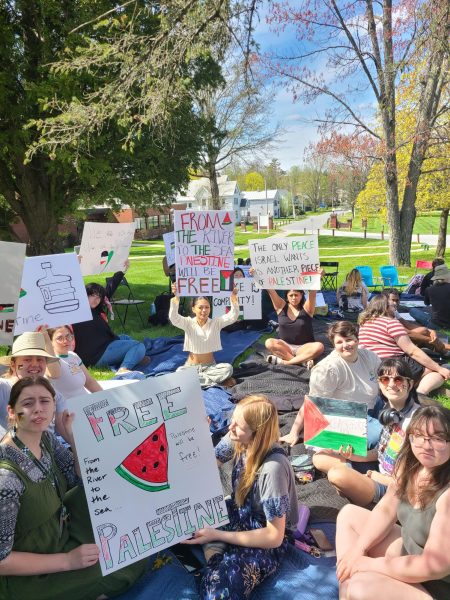Jyndon or Lohnson: A former trustee’s take on unification
Before I talk about the looming opportunity that is the unification between Lyndon and Johnson, I should probably start by telling you a bit about myself. My name is Benjamin Simone and I am a senior at Johnson State College. I am also the former student trustee to the VSC, former co-chair of the Vermont State College Student Association, and the current president of JSC Politics Club. I should note that my term with the board ended in June, and the meeting after in July, in which the decision to make a plan to merge Lyndon and Johnson, was passed under student trustee Morgan Easton from VTC who had no prior information that this would be occurring.
To delay talk about unification further in this op-ed, it is important that you, as the reader, know some essential facts about the VSC. As was clear until recently, the VSC is divided up into five distinct colleges and universities: the Community College of Vermont, Vermont Technical College, Castleton University, Lyndon State College, and Johnson State College. The VSC consists of 12 thousand students roughly and 84 percent of them are Vermonters. After graduation, 83 percent stay in Vermont to work. Despite this, Vermont ranks 47th in state appropriations for higher education, making the colleges 83 percent dependent on tuition to run effectively. On top of this, the VSC, unlike UVM, attracts a high percentage of first generation college student since the VSC is the public access extension of the K-12 education system.
Over the past years, a lack of support from the state, along with declining enrollment in the state due simply to a lack of people graduating from high school, has caused the VSC to continually raise tuition for its already struggling students. Unfortunately, last year I had to vote to raise your tuition once more. Without it, we would have had more cuts in staff and faculty and would not be able to provide necessary student services. Over the past years, the VSC has done constant lobbying work in order to attempt to pressure the legislature to allocate us more funds, but to no avail. This year is one of the few where higher education funding has come up as a major topic for gubernatorial candidates.
So, that brings us to unification. When I was on the board, unification was always something present in the air but was not by any means the ideal situation. Instead, what Lyndon and Johnson had been attempting to do is form strategic alliances between the two colleges to gain the advantages of unification while still maintaining two independent institutions. Unfortunately, right now Johnson is up for reaccreditation by the New England Association of Schools and Colleges (NEASC), and they have indicated that having strategic alliances with a shared administration between the two colleges is not an option.
Early this summer, after I had left the board, the president of Lyndon State College, Joe Bertolino, left to accept a job at Southern Connecticut State University as their president. With NEASC not accepting our strategic alliance, as well as the president of LSC leaving, the unification of Lyndon and Johnson had to proceed rapidly. For this reason, in the July board of trustees meeting, the board unanimously agreed to “plan to make a plan” for unification. The plan for the board is due on Sept. 29 when the board will vote on it again, but this time in more than just concept. After this vote, the two colleges will begin the year-long process which is expected to go into effect July 1 2017.
For years, the legislature has said the colleges needed to decrease the overhead administration costs in order for them to consider giving us a greater allocation. After all, for a structure that has 12 thousand students, we have five college presidents, over 12 deans, and a number of support staff under that. While this is true, the colleges are spread out across the state, so there would be no realistic way of merging most of them aside from Johnson and Lyndon.
By exercising this option, the VSC has made it clear to the legislature that continually denying the VSC the funding it needs has brought us to the point where we can no longer be completely reliant on student tuition to run. This being an election year, the timing of the unification process also has the chance of swaying public opinion more towards the struggle of the state colleges.
So what does this mean now? Thus far, since the July board meeting, the chancellor’s office has been attempting to make this process as seamless as it can be given the timeframe and how long we have been in this process. One large unification advisory committee has been made to get voices of members from each college. The committee is split into two groups, one at Johnson and one at Lyndon. It is comprised of two faculty, two staff, and one student from each. The student representative for Johnson is Kate Abdel-Fatah, the Vice President of the SGA. This will help orchestrate the many changes that unification brings.
With the desperate situation of state colleges funding issues, the probability of unification has been increasing year after year, and this is the year that we had to give in to it. Right now there are a lot of questions, and not a lot of answers due to the timeline of the transition. Right now what is distinctly clear is that Johnson and Lyndon will share one president, Dr. Elaine Collins, and one set of deans. Details on unification of departments or staff is not entirely clear yet. This understandably causes a lot of consternation, especially since the expectation is that a lot of members will have to face the possibility of commuting from Johnson to Lyndon or vice versa.
This situation is less from ideal, that is clear. If I were a faculty or staff member I would be upset by this situation and the lack of clarity about what will happen to my job. But, at the same time: I understand the immediacy of the unification process, and how the board did not have much of a choice when putting this together. What is necessary to understand from this is that now we have pulled the last card we have. If the legislature continues its inaction, then we are essentially out of options on cost-saving measures.
While we are in a limbo period right now as to what the details are, the chancellor’s office has made it expressly clear that student life will be improved by this unification and in a lot of ways students will see advantages that one college is unable to provide. There is no doubting that unification is a challenging process, and that there will be negative side effects that are not yet known, but to reiterate what I said earlier, this is our last card we have to play and if we do not want to see further cuts then the legislature needs to start doing its job.



